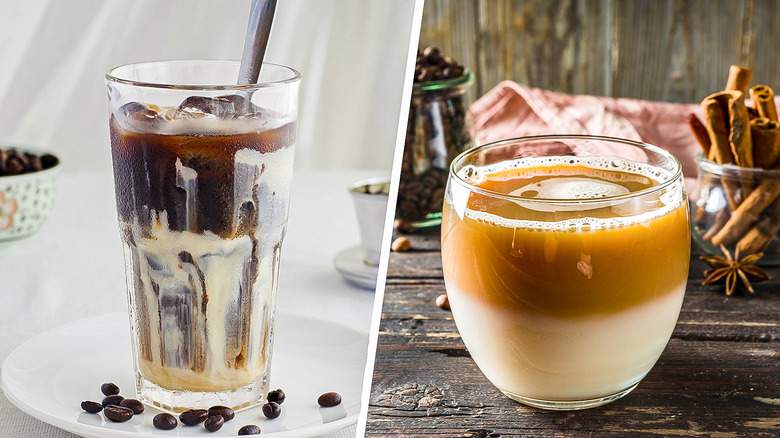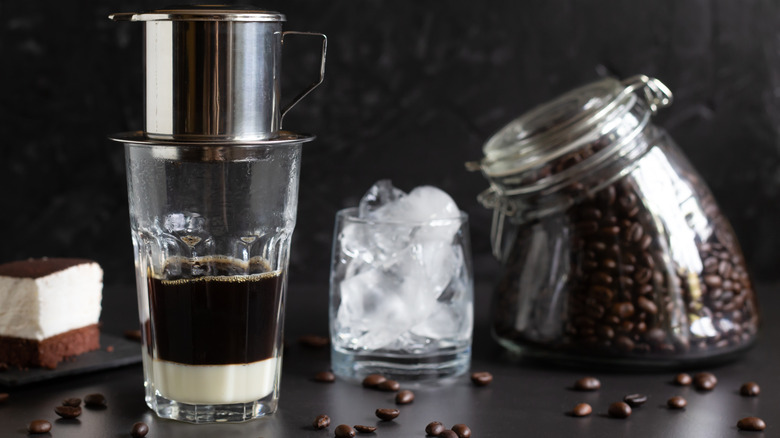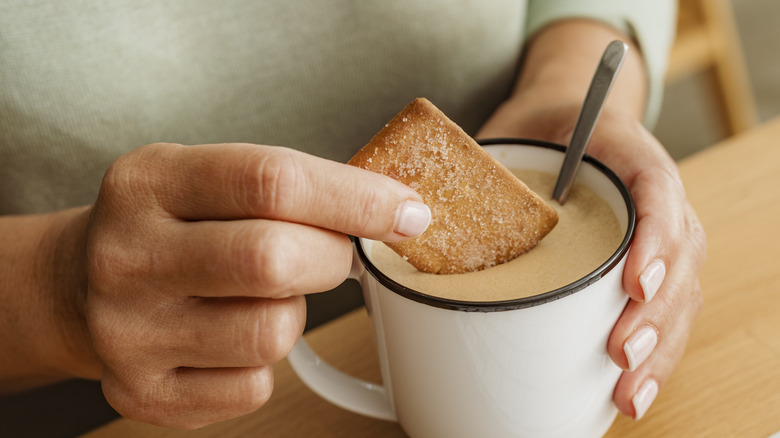The Difference Between Vietnamese Coffee And Spanish Lattes
One of the great perks of traveling is enjoying the hundreds of unique coffee drinks from around the world. Luckily, thanks to the internet, you no longer have to be an intrepid traveler to enjoy many of these recipes. From Australia's elite flat whites to Indonesia's Kopi Luwak, there's truly no limit to the ways you can enjoy a cup of coffee. That said, it's also remarkable how two beverages from distant locations can be so incredibly similar, as is the case for Vietnamese iced coffee, known as ca phe sua da, and Spanish lattes, known as café con leche.
Vietnam and Spain are thousands of miles apart, but both of these beverages include a base of strong coffee and sweetened condensed milk; what's more, both drinks have been staples in their respective countries for a very long time. Although sweetened condensed milk was invented in 19th-century Europe, the canned beverage made its way to Vietnam via French colonizers, who occupied Vietnam from the late 1800s until the 1950s. Despite these two drinks' surface-level similarities, however, they require different coffee beans, milk ratios, and brewing methods, and they're served at different temperatures. Ultimately, they also taste quite different from one another, each providing a unique coffee-drinking experience.
How Vietnamese coffee is made
When you think of coffee beans and where they grow, you might envision Ethiopia or Colombia, but Vietnam is actually the second-largest grower in the world. In particular, it's the largest global producer of robusta beans, the kind used to create Vietnamese coffee. One distinction between robusta and the more common arabica coffee beans is that the former variety has a stronger, bolder flavor and a higher caffeine content. Some describe it as a slightly bitter, peanut-y taste.
To make coffee from these beans, brewers use a phin filter, which holds ground beans in a chamber above a filter with small holes. The filter is placed on top of the glass you intend to drink from, and hot water is poured over the beans. This is quite similar to many pour-over methods seen elsewhere.
Condensed milk is typically added to the bottom of the glass before the brewing begins, creating a lovely visual effect. Vietnamese coffee is reliably served over plenty of ice. Some like to add it after the brew is finished, while others add it with the milk. Still others pour the coffee-milk mixture over a glass of ice after brewing. The condensed milk adds a rich, creamy sweetness that balances out the robusta coffee's stronger notes, and the ice makes it perfect for a hot day — this is ideal in Vietnam, where some areas have an average daily temperature of about 80 degrees Fahrenheit, even in the winter.
How Spanish lattes are made
Perhaps the biggest flavor difference between Spanish lattes and Vietnamese coffee is the type of beans used. Unlike Vietnamese coffee with its pungent robusta beans, the Spanish latte relies on arabica beans, which hail from Ethiopia in East Africa. These are a far more popular variety than robusta and tend to have a much sweeter, smoother flavor. Rather than using extremely strong coffee, Spanish lattes use a base of two espresso shots. Espresso can be achieved in several ways, such as via a pressure-driven machine (used in professional coffee shops and available on some high-end espresso machines for your home) or through a stovetop espresso maker like the moka pot.
Once the double shot of espresso is brewed, it's added to a mug or glass along with a few tablespoons of sweetened condensed milk and regular milk. Some recipes call for warmed regular milk, while others add it cold if they're seeking a more refreshing beverage. The final drink is lightly sweet, mild, and comforting.
In addition to its distinctions from Vietnamese-style coffee, the Spanish latte is also unique from other traditional European drinks. Standard European lattes don't use condensed milk, and their regular milk is generally heated to around 145 degrees Fahrenheit. Spanish lattes, on the other hand, contain regular milk that may or may not be heated, but if it is, it's scalding — anywhere between 170 and 181 degrees Fahrenheit, though this may vary depending on your barista.


